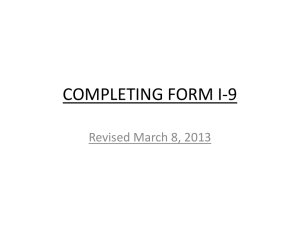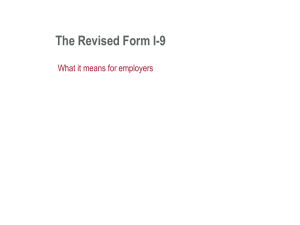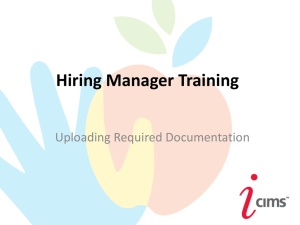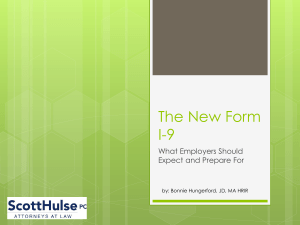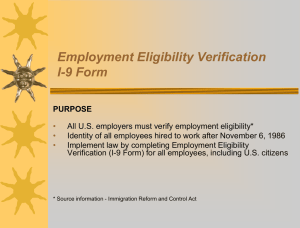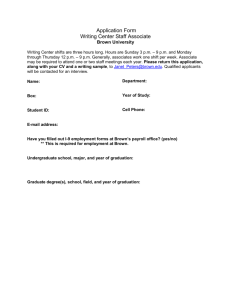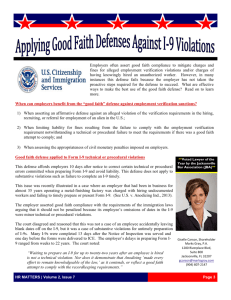Stephen M - Perlitsh
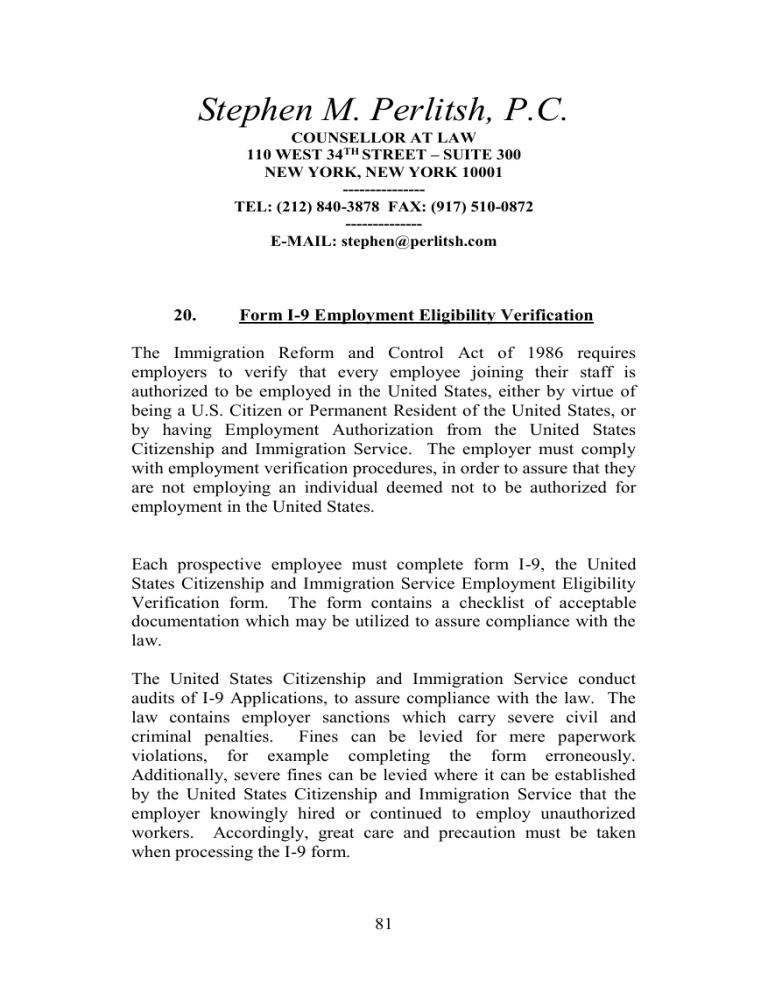
Stephen M. Perlitsh, P.C.
COUNSELLOR AT LAW
110 WEST 34 TH STREET – SUITE 300
NEW YORK, NEW YORK 10001
---------------
TEL: (212) 840-3878 FAX: (917) 510-0872
--------------
E-MAIL: stephen@perlitsh.com
20. Form I-9 Employment Eligibility Verification
The Immigration Reform and Control Act of 1986 requires employers to verify that every employee joining their staff is authorized to be employed in the United States, either by virtue of being a U.S. Citizen or Permanent Resident of the United States, or by having Employment Authorization from the United States
Citizenship and Immigration Service. The employer must comply with employment verification procedures, in order to assure that they are not employing an individual deemed not to be authorized for employment in the United States.
Each prospective employee must complete form I-9, the United
States Citizenship and Immigration Service Employment Eligibility
Verification form. The form contains a checklist of acceptable documentation which may be utilized to assure compliance with the law.
The United States Citizenship and Immigration Service conduct audits of I-9 Applications, to assure compliance with the law. The law contains employer sanctions which carry severe civil and criminal penalties. Fines can be levied for mere paperwork violations, for example completing the form erroneously.
Additionally, severe fines can be levied where it can be established by the United States Citizenship and Immigration Service that the employer knowingly hired or continued to employ unauthorized workers. Accordingly, great care and precaution must be taken when processing the I-9 form.
81
An employer cannot specify what forms are acceptable for presentation, in processing the I-9. To do so could lead to fines and penalties. Additionally, the fact that a document utilized to establish employment eligibility for the I-9 may expire cannot be utilized as grounds for refusal to hire that individual and may constitute illegal discrimination.
Section 1 of the I-9 is completed and signed by the employee on the first day of employment. In this section, the employee states that they are either a citizen or a national of the United States, a Lawful
Permanent Resident, or an alien authorized to work in the United
States.
Section 2 of the I-9 is completed and signed by the employer. The employer must examine the documentation presented by the employee, determine whether the document appears genuine and verify that it is among the documents listed on the back of the I-9 as acceptable to the United States Citizenship and Immigration Service to verify eligibility for employment in the United States. The employer then lists in Section 2, the document(s) reviewed. The employee has until the third day of employment to provide appropriate documentation establishing identity and employment eligibility.
The reverse side of the form I-9 containing the lists of acceptable documents for employment eligibility verification has three separate lists. List A is a list of ten acceptable documents that establish both identity and employment eligibility. The employee only need submit one document from List A in order to establish eligibility for employment. Among the acceptable documents included in List A are U.S. passport (whether expired or unexpired), I-551 Permanent
Resident Card with a photograph of the employee, an unexpired
Employment Authorization Document issued by the United States
Citizenship and Immigration Service which contains the employee’s photograph, or an unexpired foreign passport with I-551 stamp or attached USCIS Form I-94 indicating unexpired employment authorization.
82
If the employee does not possess, or chooses not to submit a document from List A, the employee can provide one document from List B and one document from List C. List B provides a listing of 12 documents that establish identity, for example a Driver’s
License or ID card issued by a state which contains a photograph or information such as a name, date of birth, gender, height, eye color and address, Voter’s Registration Card or Driver’s License issued by a Canadian government authority.
List C provides a listing of documents that establish employment eligibility. Among the acceptable documents listed are a U.S. Social
Security Card, bearing no restrictions prohibiting employment,
Certification of Birth Abroad, issued by the Department of State and an original or certified copy of a birth certificate issued by a state county or municipal authority.
Section 3 of form I-9 is completed by the employer when form I-9 needs to be updated. For example, if the employee changes their name, is rehired, or if the previous grant for employment authorization expired and has been extended, then section 3 is executed by the employer.
The employer should maintain a system whereby I-9 forms are updated when the documentation supporting them are due to expire.
This will help avoid a paperwork violation of IRCA and also help avoid fines and penalties for incomplete or inaccurate forms. It is also recommended that the employer maintain copies of the documents submitted by the employee to support the I-9. In the event of an audit, the availability of these copies will establish the good faith effort to comply with USCIS regulations.
The original I-9's and support documentation should be maintained in a central file at one location at the place of employment. That way, in the event of an audit, or periodic review by the employer, the I-9's will be easy to locate.
As with all audits, an audit of form I-9 is not a pleasant experience.
However, the Department of Homeland Security is required to give three days notice as to any I-9 audit. This will give the employer ample time to locate the I-9's and prepare for the audit. In the event that the audit results in the issuance by the USCIS of a Notice of Intent to Fine,
83
the Notice will recite details as to the alleged violations and state a proposed penalty. The employer will then have 30 days to contest the
Notice and ask for a hearing before an Administrative Law Judge. If the judge rules against the employer, the employer has 45 days to file a petition to the Court of Appeals requesting a review.
The United States Immigration and Customs Enforcement is authorized to perform raids with appropriate search warrants, without notice.
Although compliance with IRCA and completing form I-9 may be difficult at times, the employer should take great care in assuring the accuracy of the form and acceptability of the documentation utilized in support of the form.
Last updated: March 2, 2008
84
